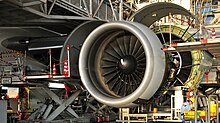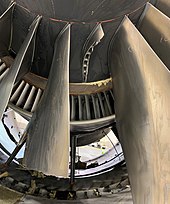Pratt & Whitney PW4000
[1] Development of the 64,000–68,000 lbf (280–300 kN), 100 in (2.5 m)-fan version began in December 1991 for the Airbus A330, was FAA certified in August 1993, and made its first flight two months later.[1] The Advantage 70 upgrade package for the PW4168A, which powered around one-third of the active Airbus A330 fleet, was launched at the 2006 Farnborough Airshow, increasing thrust to 70,000 lbf (311 kN), and reducing fuel burn by about 1.2% as well as overall operating costs by as much as 20%.The 98,000 lbf (440 kN) PW4098 received FAA certification in July 1998 and was introduced on the Boeing 777-300 in September 1999 but was a few years later discontinued due to core temperature problems and fuel burn that was not appealing to airlines..[1] In 2000, over 2,000 PW4000 engines had accumulated over 40 million hours of service with 75 operators.[1] Like other modern aircraft power plants, it has a Full Authority Digital Engine Control (FADEC), for better fuel economy and reliability.[4] Furthermore, single-crystal alloys allows higher temperature capability and PW's Floatwall combustor liners improve durability and maintainability.






Boeing 777TurbofanPratt & WhitneyAirbus A300Airbus A310Airbus A330Boeing 747-400Boeing 767McDonnell Douglas MD-11Scaled Composites StratolaunchPratt & Whitney JT9DEngine Alliance GP7000axial-flowhigh-bypass turbofanthrustwide-body aircraftExtended-range Twin-engine OperationsFarnborough AirshowUnited AirlinesFull Authority Digital Engine Controlfuel economysingle-crystalcombustorBoeingAirbusMcDonnell DouglasBoeing 767-300ERBoeing DreamlifterBoeing KC-46AAirbus A330-200Boeing 777-200UAL1175metal fatigueKona, Hawaii777-200ERAuckland, New ZealandLos AngelesKorean Air Flight 2708Tokyo-Haneda AirportUnited Airlines Flight 1175Japan AirlinesOkinawaUnited Airlines Flight 328Denveremergency Airworthiness DirectiveThermal Acoustic InspectionJin AirVietnam AirlinesMelbourne AirportTokyo NaritaLongtail Aviation Flight 5504747-412Maastricht Aachen AirportLiège AirportZürichShannonIrelandCompressorTurbineBypass ratioOverall pressure ratioB747-400Aviadvigatel PS-90General Electric CF6General Electric GE90Pratt & Whitney PW2000Progress D-18TRolls-Royce RB211Rolls-Royce Trent 700Rolls-Royce Trent 800List of aircraft enginesAviation WeekAustralian Transport Safety BureauAviation Safety Networkaircraft enginesRadial enginesR-1340R-1535R-1690R-1830R-1860R-2000R-2060R-2180-AR-2180-ER-2270R-2800R-4360Double WaspHornet (A)Hornet BTwin HornetTwin Wasp (R-1830)Twin Wasp (R-2000)Twin Wasp ETwin Wasp JuniorWasp seriesWasp JuniorWasp MajorYellow JacketH piston enginesX-1800/XH-2600XH-3130 (XH-3730)Free-piston gas turbinesTurbojetsTurbofansGP7000JTF10APW1000GPW1120PW2000PW5000PW6000RTF-180SuperFanTurbopropsTurboshaftsJFTD12T800-APWPropfans578-DXRocket enginesXLR-129Aeroderivative gas turbine enginesGG4/FT4Pratt & Whitney Canada